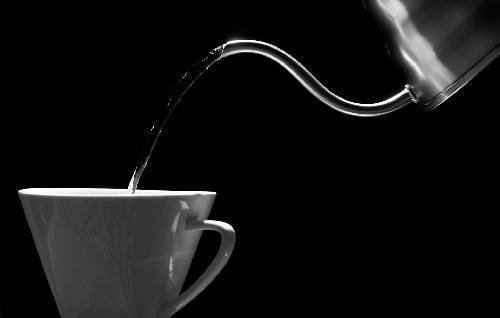
A coffee kettle is fundamentally like any other kettle. It is a device used to heat up water and then pour that water over something so that, whatever that something is, diffuses into your hot water. That “something” is usually tea or coffee.
But there are a few differences between a normal kettle and a coffee kettle- namely, the spout. Tea is a little more forgiving about your pour technique. At least, as far as we coffee drinkers know, it doesn’t seem to make much difference.

With manual brewing methods like the pour over method, the pour technique can really affect the end result. Temperature is also extremely important to the flavor of your coffee.
While you can manage to perfect both of these things without a specialized pour over coffee kettle, it is far more efficient and reliable to use a kettle that’s designed for the job. In this article, we’ll talk about how the temperature and the pour affect your brew and then take a look at how different coffee kettles can help you achieve perfection.
Why a Pour over Kettle Makes a Difference
When brewing coffee, getting the water right is essential to brewing a good cup. Here are some of the reasons water is so important:

- Temperature: effects how quickly or slowly coffee oils are extracted. Scalding hot water will burn the grounds and pull out the bitters way too quickly. A good temperature (between 175 and 205 depending on brew method) will efficiently extract the oils but at a slow enough rate that you can stop the brewing before the bitters start to extract.
- Pour: beyond temperature, the pour technique affects extraction. In a drip machine, the shower of drips will saturate certain parts of the grounds while leaving other parts either totally dry or only partially extracted. In a pour over technique, dumping water over it too quickly will result in uneven extraction or over extraction.
A well-executed pour is one that is:

- Slow enough to allow the sufficiently diffused water to drip out before fresh water is poured.
- Steady and constant enough that you do not have to stop pouring at any point because it does not ever overflow.
- Rotated enough so that you are not pouring everything down the center. Instead, you are pouring in concentric circles to evenly wet all of the grounds. This prevents certain parts from being over extracted while other parts still retain those precious oils you want.
The key innovation that a pour over coffee kettle offers is the spout design. The slender goose neck design regulates the flow of water in such a precise way that you can effortlessly maintain a steady, consistent stream of water for your coffee.
With that taken care of, all you have to worry about is temperature and making sure that you move the kettle to create concentric circles throughout the grounds for an even soaking and extraction.
Choosing the Best Pour Over Kettle
Any good kettle for pour over coffee needs to have that signature goose neck spout. Everything else is a matter of your own personal preference.
For example, you can find an electric coffee kettle which allows you to program specific water temperatures so you no longer have to either guess what the temperature is or repeatedly measure it with a thermometer.
Pour over coffee kettles come in a wide range of prices ranging from “ok, I can handle that” to “dear god, why would anyone spend that much money on a kettle?” The different price points offer different features.

Here are some of the features you will find. Pick out the ones you find most important for you and then start shopping around for a kettle that suits you.
- The spout: the main advantage is this cute little curved spout that slows and regulates water flow. You can also get a flow restrictor in case the spout is not slowing it down enough but, in our opinion, if you need to buy a flow restrictor for it, it’s not a very effective coffee kettle so you may want to spring for one that doesn’t need any assistance on that front.
- Stainless steel: this anti-rust material is also durable and safe for stove top heating. It’s not as important if you are getting an electric kettle but it does look nice.
- Electric: our favorite thing about going electric is when it offers temperature programming. Otherwise, there’s no real difference in terms of function between a stove top and an electric. It may be a tiny bit faster but not enough to warrant spending a lot more money on it.
- Thermometer: if it doesn’t allow you to program a temperature, a built in thermometer to tell you what the temperature is can be extremely helpful. (The Coletti kettle has a built in temperature gauge that shows you when your water reaches the ideal temp for brewing.)
If the one you want the most is a little too close to that “dear god” price range, consider the fact that it will likely last you a lifetime (or quite a few years if it is a good electric one).
Also remember that you should give it a thorough cleaning every 4-6 weeks. Even though it’s just holding water, that water can start to leave some mineral buildup that will affect the flavor and can start to clog up the spout. Use baking soda and hot water. Or do a vinegar soak to deal with tough build up.

